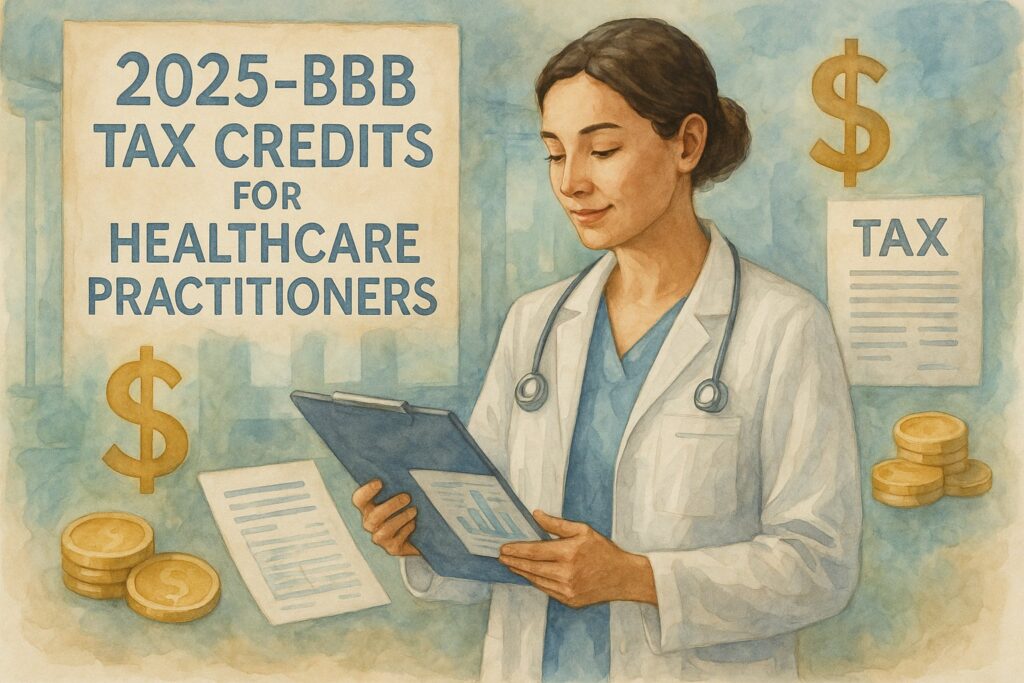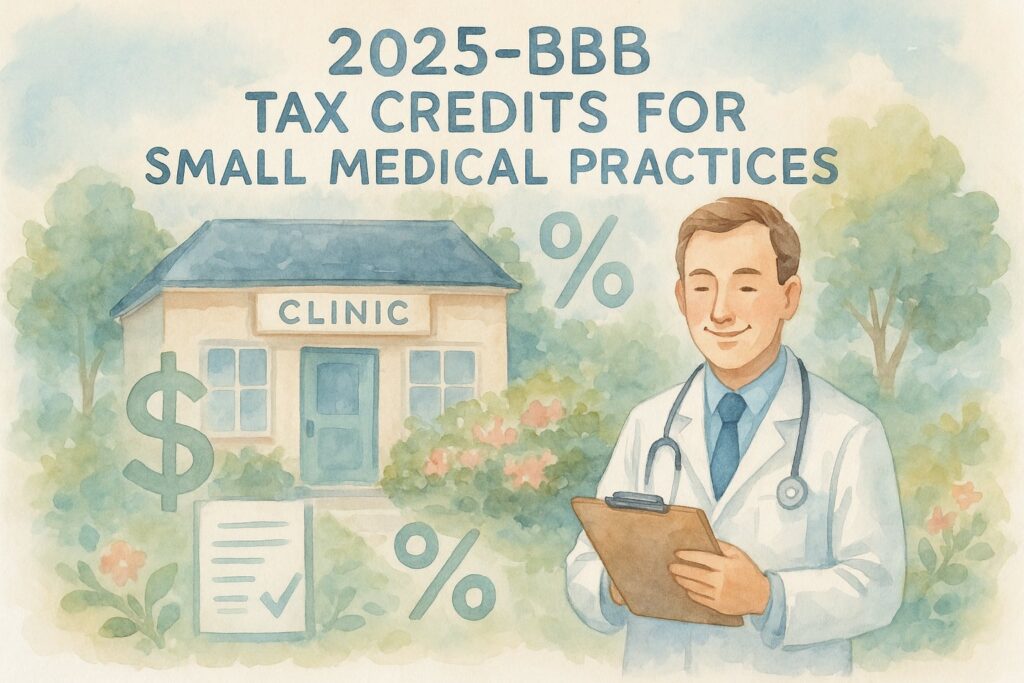
Healthcare tax credits in 2025 offer significant opportunities for medical practices to reduce costs and improve their bottom line. Small practices with fewer than 25 employees can claim up to 50% of their health insurance premiums through small business health care tax credits, while facilities investing in energy-efficient equipment may qualify for additional green energy incentives.
The landscape of healthcare tax credits has evolved with recent legislative changes, making it crucial for practice owners to understand which credits remain available. Premium tax credits continue to support both employers and employees, though some enhanced credits face expiration at the end of 2025. This creates urgency for healthcare businesses to maximize their current credit opportunities.
Understanding these credits can translate into thousands of dollars in savings for your practice. From employee retention incentives to sustainability upgrades, the right combination of healthcare tax credits can significantly impact your operational costs and competitive position in the market.
Key Takeaways
- Small healthcare practices can claim substantial tax credits for employee health insurance premiums and benefit programs
- Green energy upgrades in medical facilities may qualify for additional tax incentives beyond standard healthcare credits
- Several healthcare-related tax credits face expiration deadlines in 2025, making immediate action essential for maximizing savings
Essential Healthcare Tax Credits for 2025

Healthcare providers can access several significant tax credits in 2025, with premium tax credits maintaining their current structure while enhanced provisions face expiration concerns. Small practices benefit from employee health coverage credits, and green energy upgrades qualify for substantial federal incentives.
Highlights of Healthcare-Specific Tax Credit Changes
The Small Business Health Care Tax Credit remains available for healthcare practices with fewer than 25 full-time equivalent employees. You can claim up to 50% of premiums paid for employee health insurance if you meet specific wage and participation requirements.
Your practice qualifies when average annual wages stay below $64,000 per employee. The credit phases out as wages approach this threshold and employee count increases.
Premium tax credits under the Affordable Care Act continue operating under current rules for 2025. However, enhanced premium tax credits face potential expiration at year-end, creating uncertainty for future coverage affordability.
Green energy tax credits offer substantial opportunities for healthcare facilities. The Investment Tax Credit (ITC) provides 30% credits for solar installations completed by December 31, 2025.
Energy-efficient equipment upgrades qualify for Section 179D deductions up to $1.88 per square foot for healthcare buildings meeting efficiency standards.
Eligibility Criteria for Healthcare Providers
Small healthcare practices must employ fewer than 25 full-time equivalent employees to qualify for health care tax credits. You calculate this by adding full-time employees plus full-time equivalents of part-time workers.
Your average annual wages must not exceed $64,000 per employee. Include all compensation, wages, and benefits when calculating this threshold.
Coverage requirements mandate you provide health insurance through the Small Business Health Options Program (SHOP) marketplace. Alternative arrangements may disqualify your credit eligibility.
For energy credits, your healthcare facility must meet specific efficiency standards. Buildings require energy consumption reductions of at least 25% compared to standard reference buildings.
Documentation requirements include maintaining detailed records of employee hours, wages, and premium payments. Energy upgrade credits need professional certification of efficiency improvements and installation compliance.
Key Deadlines and Compliance Requirements
File Form 8941 with your annual tax return to claim small business health care credits. The deadline aligns with your practice’s regular tax filing date, including extensions.
Energy credit deadlines vary by project type:
- Solar installations: December 31, 2025 for 30% credit rate
- Energy efficiency upgrades: Projects must be placed in service by December 31, 2025
Quarterly estimated tax payments should reflect anticipated credit amounts to avoid underpayment penalties. Adjust payments when claiming substantial energy credits.
Maintain comprehensive documentation for three years after filing. Include employee census data, premium payment records, and wage calculations for health care credits.
Energy project compliance requires retention of manufacturer certifications, installation contracts, and efficiency testing results. Professional energy audits may be necessary for larger facilities claiming efficiency credits.
Tax Credits for Small Medical Practices

Small medical practices can access significant tax savings through three primary credit categories. The small business health care tax credit alone can reduce premium costs by up to 50%, while specialized deductions and rural practice incentives provide additional opportunities for substantial savings.
Small Business Health Care Tax Credit
You can claim up to 50% of health insurance premiums paid for employees through this federal tax credit. The credit applies when you purchase coverage through the Small Business Health Options Program (SHOP) marketplace.
Your practice must meet specific eligibility requirements. You need fewer than 25 full-time equivalent employees with average wages below $64,000 annually in 2025.
Maximum Credit Rates:
- For-profit practices: 50% of premiums
- Tax-exempt organizations: 35% of premiums
The credit phases out as your employee count approaches 25 or average wages reach the threshold. You must pay at least 50% of employee premium costs to qualify.
You claim this credit using IRS Form 8941. The form documents your qualified health insurance premium payments and calculates your eligible tax credit amount.
Qualified Business Income Deduction Opportunities
The Section 199A deduction allows you to deduct up to 20% of qualified business income from your medical practice. This deduction applies to pass-through entities including sole proprietorships, partnerships, and S-corporations.
Your practice faces income limitations that phase out the full deduction. For 2025, the phase-out begins at $191,950 for single filers and $383,900 for joint filers.
Medical practices often qualify as specified service businesses, which creates additional restrictions. Above the income thresholds, your deduction becomes limited by W-2 wages or the combination of wages plus 2.5% of qualified property.
You can maximize this deduction through strategic equipment purchases and wage management. Investing in medical equipment increases your qualified property basis, potentially expanding your available deduction.
Tax Advantages for Rural and Underserved Practices
Rural medical practices can access enhanced depreciation benefits for medical equipment purchases. Section 179 allows immediate expensing of up to $1.22 million in equipment costs for 2025.
Rural Practice Benefits:
- Enhanced equipment depreciation
- Increased Section 179 limits
- State-specific rural healthcare credits
- Loan forgiveness programs with tax implications
Practices in Health Professional Shortage Areas may qualify for additional state tax credits. These credits vary by state but often provide significant reductions in state income tax liability.
You should coordinate federal and state benefits carefully. Some rural practice incentives affect your federal tax calculations, requiring proper documentation and timing strategies.
Student loan forgiveness programs for rural practitioners create taxable income events. Plan for potential tax liability when participating in these programs to avoid unexpected tax burdens.
Green Energy Upgrade Incentives in Healthcare

Healthcare organizations can access significant tax savings through the Inflation Reduction Act’s expanded energy incentives, with credits covering up to 30% of eligible green energy investments. These programs specifically benefit medical practices investing in solar systems, energy-efficient equipment, and sustainable facility improvements.
Energy-Efficient Property Credit for Clinics
You can claim substantial tax credits for energy-efficient improvements to your medical facility through the commercial buildings energy efficiency deduction. This incentive covers interior lighting systems, HVAC upgrades, and building envelope improvements.
The deduction applies to equipment that reduces your facility’s energy consumption by at least 25% compared to standard baselines. Medical practices installing LED lighting systems, smart thermostats, or high-efficiency heating and cooling equipment qualify for these benefits.
Eligible improvements include:
- Energy-efficient lighting retrofits
- Advanced HVAC control systems
- Insulation and window upgrades
- Smart building automation systems
Your practice can deduct up to $5.00 per square foot for improvements achieving 50% energy reduction. Even smaller efficiency gains of 25-49% qualify for partial deductions ranging from $0.60 to $3.60 per square foot.
Renewable Energy System Installation Tax Benefits
Solar panel installations at your healthcare facility qualify for the federal Investment Tax Credit (ITC), currently at 30% of total system costs. This credit applies to both for-profit practices and tax-exempt healthcare organizations through direct pay provisions.
Wind energy systems also qualify for the same 30% credit rate. Small practices installing rooftop solar or ground-mounted systems can significantly reduce their installation costs through these incentives.
Key credit features:
- 30% credit rate through 2032
- Includes installation costs and equipment
- No maximum credit limit for commercial systems
- Available to tax-exempt organizations via direct pay
Battery storage systems installed alongside renewable energy qualify for the same credit percentage. Your practice can combine multiple renewable technologies to maximize tax benefits while reducing long-term energy costs.
Tax Savings for Sustainable Facility Upgrades
Your healthcare practice can access additional incentives for comprehensive sustainability improvements beyond basic energy efficiency measures. These credits support broader environmental initiatives that reduce operational costs while improving patient care environments.
Geothermal heat pump systems qualify for the renewable energy credit at 30% of installation costs. These systems provide both heating and cooling for medical facilities with significantly lower energy consumption than traditional HVAC systems.
Electric vehicle charging stations installed for staff or patient use qualify for separate tax credits. The infrastructure supports your practice’s sustainability goals while providing valuable amenities.
Additional qualifying upgrades:
- Energy storage systems
- Microgrid installations
- Electric vehicle charging infrastructure
- Combined heat and power systems
Your practice can stack multiple credits when implementing comprehensive green energy upgrades. The combination of efficiency improvements and renewable energy installations maximizes both tax savings and long-term operational cost reductions.
Maximizing Employee Benefit and Retention Credits

Healthcare practices can claim substantial tax credits for employer-provided health insurance, employee wellness programs, and hiring qualified healthcare staff. These credits directly reduce your tax liability dollar-for-dollar and provide significant savings for practices investing in their workforce.
Tax Credits for Employer-Provided Health Insurance
The Small Business Health Care Tax Credit offers up to 50% of premium costs for eligible healthcare practices. You qualify if you employ fewer than 25 full-time equivalent employees with average wages below $64,000 in 2025.
Your practice must contribute at least 50% of employee premium costs. The maximum credit applies when you have 10 or fewer employees earning average wages of $32,000 or less.
You can claim this credit for two consecutive tax years. Purchase qualifying plans through the Small Business Health Options Program (SHOP) Marketplace to ensure eligibility.
Key requirements include:
- Fewer than 25 full-time equivalent employees
- Average annual wages below $64,000
- Employer pays at least 50% of premiums
- Coverage purchased through SHOP Marketplace
Incentives for Employee Wellness Programs
Healthcare practices investing in employee wellness programs can claim credits through various federal and state initiatives. The Wellness Program Tax Credit allows deductions for qualified wellness expenses including health screenings, fitness programs, and preventive care initiatives.
You can deduct 100% of qualified wellness program costs as business expenses. These include on-site fitness facilities, health risk assessments, smoking cessation programs, and nutrition counseling.
State-specific wellness credits vary by location. Many states offer additional incentives ranging from $500 to $5,000 annually for comprehensive wellness programs.
Document all program costs and employee participation rates. The IRS requires detailed records showing business purpose and employee benefit to support your deductions.
Work Opportunity Tax Credit for Healthcare Staff
The Work Opportunity Tax Credit (WOTC) provides up to $9,600 per qualified healthcare employee you hire from targeted groups. Veterans, ex-felons, and long-term unemployment recipients qualify for this credit.
You must obtain certification from your state workforce agency before the employee’s start date. Submit Form 8850 within 28 days of hire to begin the certification process.
Maximum credit amounts vary by employee category:
- Veterans with service-connected disabilities: $9,600
- Veterans receiving SNAP benefits: $6,240
- Ex-felons: $2,400
- Long-term unemployment recipients: $2,400
The credit applies to first-year wages only. You must retain employees for at least 120 hours to claim partial credit and 400 hours for maximum credit amounts.
Frequently Asked Questions
Healthcare providers face specific tax credit requirements and opportunities that differ from other industries. These credits range from enhanced premium tax credits for employee health benefits to updated energy efficiency incentives for medical facilities.
What new healthcare-specific tax credits can small practices claim in 2025?
Small healthcare practices can claim the Enhanced Premium Tax Credit for employee health insurance purchased through Health Insurance Marketplaces. This credit applies when you provide qualifying health plans to employees earning moderate incomes.
The Small Business Health Care Tax Credit remains available for practices with fewer than 25 full-time equivalent employees. You can claim up to 50% of premium costs if you pay at least 50% of employee premiums.
Healthcare practices investing in digital health infrastructure may qualify for accelerated depreciation benefits. Electronic health record systems and telemedicine equipment often qualify for immediate expensing under Section 179.
How can healthcare facilities benefit from green energy tax credits this year?
Medical facilities installing solar panels can claim the federal solar Investment Tax Credit at 30% of installation costs. This credit applies to hospitals, clinics, and private practices that own their buildings.
Energy-efficient HVAC systems in healthcare facilities qualify for commercial building deduction benefits. You can deduct up to $5 per square foot for systems that reduce energy consumption by 50% or more.
Battery storage systems paired with renewable energy installations qualify for additional tax credits. These systems help healthcare facilities maintain power during outages while reducing long-term energy costs.
What are the updated guidelines for claiming the Small Business Health Care Tax Credit?
You must have fewer than 25 full-time equivalent employees with average wages below $64,000 annually. The credit phases out as employee count and wages increase above these thresholds.
Your contribution must cover at least 50% of employee-only premium costs. Family coverage contributions don’t count toward the 50% requirement, but you can still receive credits for those premiums.
The credit lasts for two consecutive tax years once you begin claiming it. You must purchase coverage through the Small Business Health Options Program marketplace to qualify.
What employee benefits-related tax deductions are available for healthcare providers in 2025?
Health Savings Account contributions made by employers remain fully deductible business expenses. You can contribute up to $4,300 for individual coverage and $8,550 for family coverage in 2025.
Flexible Spending Account administration costs qualify as deductible business expenses. Employee contributions to these accounts reduce your payroll tax obligations.
Professional development and continuing education expenses for healthcare staff remain fully deductible. Conference fees, certification costs, and required training qualify as ordinary business expenses.
How has the Small Business Health Options Program (SHOP) marketplace evolved for 2025 in terms of tax credits?
SHOP marketplace requirements remain unchanged for tax credit eligibility. You must purchase employee health insurance through SHOP to claim the Small Business Health Care Tax Credit.
Premium tax credits for employee coverage purchased through SHOP are now processed more efficiently. The advance payment system allows you to receive credits throughout the year rather than waiting until tax filing.
State-based SHOP marketplaces have expanded plan options in many regions. More insurance carriers participate, providing healthcare practices with additional coverage choices for employees.
Are there any new IRS publications or changes in 2025 affecting healthcare tax credits?
The IRS updated Publication 974 regarding Premium Tax Credits with clarified guidance for small business employers. New examples show how healthcare practices calculate and claim these credits correctly.
Form 8941 for the Small Business Health Care Tax Credit includes updated income thresholds and calculation worksheets. The form now provides clearer instructions for determining full-time equivalent employees.
New safe harbor provisions protect healthcare employers from Premium Tax Credit repayment obligations when employee income changes occur mid-year. These provisions reduce compliance risks for medical practices offering marketplace coverage.

https://shorturl.fm/a7k8n
https://shorturl.fm/0bZif
https://shorturl.fm/NSY0m
https://shorturl.fm/MGTyc
This article makes me want to go food hunting in my city.
istanbul women
Aviator game download and play instantly on your device
Зеркало казино позволяет продолжить игру без перебоев
https://shorturl.fm/3gq0H
https://shorturl.fm/jmH0Z
https://shorturl.fm/9LMnV
https://shorturl.fm/fC6d3
https://shorturl.fm/qJkBc
Thanks for putting this in simple terms.
https://shorturl.fm/vtX4E
https://shorturl.fm/IzRZl
BitStarz Casino blends classic table play with cutting-edge slots, providing smooth navigation, crisp design, and reliable customer support.
https://shorturl.fm/tuqQu
https://shorturl.fm/IHxk8
https://shorturl.fm/zjhhS
https://shorturl.fm/wZXvI
https://shorturl.fm/1tZ33
https://shorturl.fm/5uzt5
Master the Aviator game using odds and fairness notes. Access the Aviator game download guide, practice in demo, and control your risk.
Learn about session variance in the Aviator game; pick an official Aviator game download and avoid emotional swings.
Manage notifications while playing the Aviator game and clear cache after your Aviator game download.
Master the Aviator game; get the secure Aviator game download.
Review payout timing rules linked to the Aviator game; note details with your Aviator game download.
Create a pre-round checklist for the Aviator game; step one is Aviator game download.
Manage notifications while playing the Aviator game and update through the official Aviator game download.
Explore regional compliance for the Aviator game; only trust a licensed Aviator game download provider.
Analyze volatility spans in the Aviator game and couple findings with your Aviator game download.
Gear up for fast multipliers in the Aviator game; secure the official Aviator game download to play confidently.
https://shorturl.fm/MblGe
https://shorturl.fm/8eVGx
Зеркало казино открывает доступ к акциям и бонусам
https://shorturl.fm/EW46G
https://shorturl.fm/p5pp6
Color contrast and readability tested: 1win apk review.
https://shorturl.fm/vQom7
This is such a valuable article! 👏 I really like how you’ve managed to explain the topic in a clear and practical way—it feels authentic and easy to relate to. Reading it gave me some new perspectives that I can actually apply. I’m especially interested in content like this because at meinestadtkleinanzeigen.de we’re running a classifieds and directory platform in Germany that connects people with services, businesses, and opportunities across many categories. Insights like yours remind me how powerful it is when knowledge and connections come together. Thanks for sharing—looking forward to more of your work! 🚀
https://shorturl.fm/DfzZF
https://shorturl.fm/KYkNW
https://shorturl.fm/UbePL
https://shorturl.fm/vpS2O
https://shorturl.fm/OLbFp
https://shorturl.fm/AG8jr
https://shorturl.fm/1bAnr